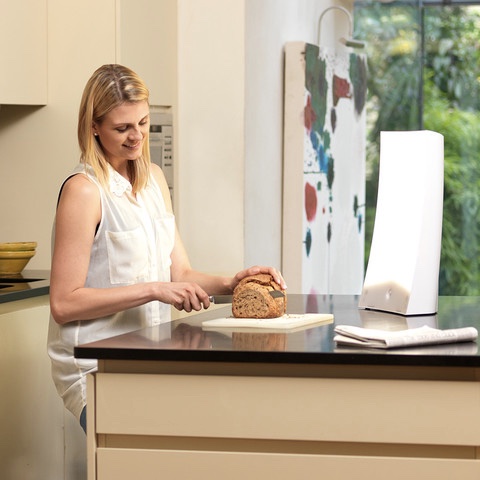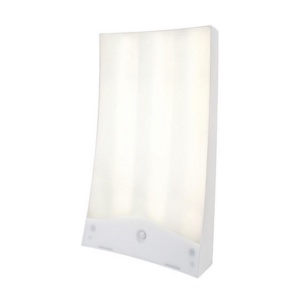Powerful Lumie Lights Donated to Huntington’s Disease Study at Cambridge University
Written by |

 Cambridge, England-based light therapy specialist Lumie will supply 24 of its most powerful light boxes, called Lumie Brazil, for use in a Huntington’s
Cambridge, England-based light therapy specialist Lumie will supply 24 of its most powerful light boxes, called Lumie Brazil, for use in a Huntington’s  disease research study at the Cambridge School of Clinical Medicine’s Neurology Unit.
disease research study at the Cambridge School of Clinical Medicine’s Neurology Unit.
 The Lumies are being donated to the research project that is investigating the efficacy and tolerability of two non-pharmaceutical interventions to improve the life and sleep quality of Huntington’s disease patients. One is bright light therapy and the other is sleep restriction therapy. The project, scheduled to get underway this month, is expected take eight months.
The Lumies are being donated to the research project that is investigating the efficacy and tolerability of two non-pharmaceutical interventions to improve the life and sleep quality of Huntington’s disease patients. One is bright light therapy and the other is sleep restriction therapy. The project, scheduled to get underway this month, is expected take eight months.
Huntington’s disease (HD) is a complex neurological genetic disorder that currently has no cure. It causes motor, cognitive, and psychiatric symptoms due to a hereditary gene defect that damages certain nerve cells in the brain. The damage progressively worsens over time, and can affect movement, cognition (perception, awareness, thinking, judgment) and behavior, ending with devastating loss of motor and executive function.
Huntington’s starts with symptoms that can include personality changes, mood swings, fidgety movements, irritability, and altered behavior, although these signs are initially often overlooked or misdiagnosed, although a blood test can confirm a faulty HD gene. Research in the U.K. in 2012 found the figure for people affected by Huntington’s to be roughly 12 per 100,000.
A 2012 article published in the journal Experimental Neurology entitled “Circadian and sleep disorder in Huntington’s disease” by Prof. A.J. Morton, of the University of Cambridge Department of Pharmacology, notes there is growing awareness that in addition to cognitive and psychiatric symptoms, there are other important non-motor symptoms associated with Huntington’s disease, including sleep and circadian abnormalities.
notes there is growing awareness that in addition to cognitive and psychiatric symptoms, there are other important non-motor symptoms associated with Huntington’s disease, including sleep and circadian abnormalities.
Morton, whose research is focused on understanding the mechanisms underlying neurodegeneration and on developing strategies to delay or prevent the death of neurons in injured or degenerating brains, particularly in Huntington’s disease, says it is not clear whether sleep-wake changes are caused directly by HD gene-related pathology, or are simply a consequence of having a neurodegenerative disease. Morton saidthat from a patient point of view, the answer is irrelevant, since sleep and circadian disturbances are antagonistic to quality of life, even in neurologically normal people. She maintains that it should be assumed be that at the very least, sleep or circadian disturbances in HD patients will contribute to their symptoms, and at worst may contribute to their progressive decline.
In her article, Morton reviews the state of scientific understanding of sleep and circadian abnormalities in Huntington’s, and also outlines a set of simple rules that can be followed to improve the likelihood of a good night’s sleep, reasoning that preventing any “preventable” symptoms is a logical first step in treating disease.
Morton observes that the long-term impact of sleep disruption in HD is unknown since there have been no large-scale sleep studies in HD, and furthermore, there has never been a study of the efficacy of pharmaceuticals that are typically used to treat sleep deficits in Huntington’s patients, and contends that better understanding of the relationship between sleep/circadian abnormalities and HD pathology is needed, if treatment of this part of HD is to be optimized.
A study co-authored by Morton with her University of Cambridge colleagues, M. Cuesta and J. Aungier of the Centre for Study and Treatment of Circadian Rhythms at the Douglas Mental Health University Institute in Montreal, Canada, notes that progressive disturbance of the sleep-wake cycle is one of the most insidious symptoms of Huntington’s disease and represents a critical management issue for both patients and caregivers. The study, “Behavioral therapy reverses circadian deficits in a transgenic mouse model of Huntington’s disease,” was published in the journal Neurobiology of Disease, before Morton’s Experimental Neurology article.
The researchers report that the R6/2 mouse model of Huntington’s shows a progressive disruption of circadian rhythmicity at both behavioral and molecular levels, although intrinsic cellular machinery that drives circadian rhythms in individual cells appears to be fundamentally intact. The report notes that circadian rhythms are controlled by a master clock located in the suprachiasmatic nuclei (SCN) and can be synchronized by light and non-photic factors such as exercise.
In their study, investigators aimed to test whether stimulating the SCN directly could prevent the loss of circadian rhythmicity in R6/2 mice, using combinations of bright light therapy and voluntary exercise as treatment regimens. They found that all treatments had some beneficial effects, as measured by delayed disintegration of the rest-activity rhythm and improved behavioral synchronization to the light-dark cycle. The best effects were observed in mice treated with a combination of bright light therapy and restricted periods of voluntary exercise.
They conclude that while neither the cause nor the consequence of deteriorating sleep-wake activity in HD patients is known, their findings can be translated immediately to human patients with little cost or risk. Both light therapy and restricted exercise regimens are non-pharmacological interventions that are relatively easy to schedule, and researchers suggest that improved circadian rhythmicity is likely to have beneficial knock-on effects on mood and general health in HD patients, and that until effective treatments are found for Huntington’s, strategies that reduce deleterious effects of disordered physiology should be part of patient treatment programs.
Lumie is a light therapy specialist whose products are proven to promote a healthy sleep/wake cycle by regulating the body’s internal clock, as well as helping users feel more energetic and productive throughout the day. Lumie Brazil offers a much higher light intensity than standard lighting, emitting 10,000 lux at 35cms. To put those metrics into context, on a bright day, brightness levels will range from 10,000 to 25,000 lux up to 32,000 to 100,000 lux in direct sunlight.
A study report recently published in the journal Sleep Medicine Reviews titled “The effects of light therapy on sleep problems: A systematic review and meta-analysis,” co-authored by A. van Maanen, A.M. Meijer, K.B. van der Heijden, and F.J. Oort of the University of Amsterdam and Leiden University in The Netherlands, notes that while bright light therapy has seemed a promising avenue of treatment for sleep problems, research shows inconclusive results. Their meta-analysis is the first to systematically review the effect of light therapy on sleep problems in general and on specific types of sleep problems in particular (circadian rhythm sleep disorders, insomnia, and sleep problems related to Alzheimer’s disease and dementia).
The researchers reviewed 53 studies with a total of 1,154 participants, examining in particular effects on separate circadian and sleep outcomes. Light therapy was found effective in the treatment of sleep problems in general, and for circadian rhythm sleep disorders, insomnia, and sleep problems related to Alzheimer’s disease and dementia specifically. For circadian rhythm sleep disorders, effects were smaller for randomized controlled trials. For insomnia, the investigators found greater effects in studies using a higher light intensity, and for sleep problems related to Alzheimer’s disease and dementia, larger effects were found for studies with more female participants.
They conclude that light therapy is effective for sleep problems in general, particularly for circadian outcomes and insomnia symptoms, although most effect sizes are small to medium.
Lumie has been researching and designing bright lights to treat seasonal affective disorder (SAD) and other conditions since 1991. The company’s Bodyclock dawn simulator is an alarm that awakens the user with increasing levels of light — the world’s first wake-up light product which brought light therapy into the mainstream. The company also designed and developed Lumie Clear, a handheld device that uses combined blue and red light therapy to treat acne.
Lumie’s lighting products have been developed closely with the scientific community, are based on published research, and designed in-house at the company’s Cambridge base. Lumie is a member of the EuRhythDia consortium that is investigating circadian rhythms as they relate to type 2 diabetes, and is working with Liverpool John Moore’s University sports science department, and continues to research new applications for light therapy.
All of Lumie’s products are medical devices certified to the UK Medical Devices Directive and supplied to the National Health Service (NHS) on an occasional basis. Distance and brightness levels (lux) are independently verified, and Lumie is registered with the UK government’s Medicines and Healthcare Products Regulatory Agency.
Lumie notes that bright light has been shown to have immediate impact, increasing levels of alertness, boosting mood, and improving performance, and works especially well first thing in the morning to help people get going, and also for surmounting the post-lunch slump.
And if a simple intervention like light therapy is able to tackle some of the symptoms of Huntingdon’s disease, there seems little downside. Sleeping better or being awake and asleep at normal times can have a significant impact on quality of life, not just for HD patient but also for their caregivers and family.
Brazil lightboxes and other Lumie products are available in the UK through https://www.lumie.com as well as major retailers like John Lewis, Boots, Amazon, Selfridges, Neals Yard, and wiggle.co.uk, and the company has an expanding network of distributors across Europe and North America. For consumers buying through https://www.lumie.com, they provide a 45-day trial period on all products and a dedicated customer careline.





